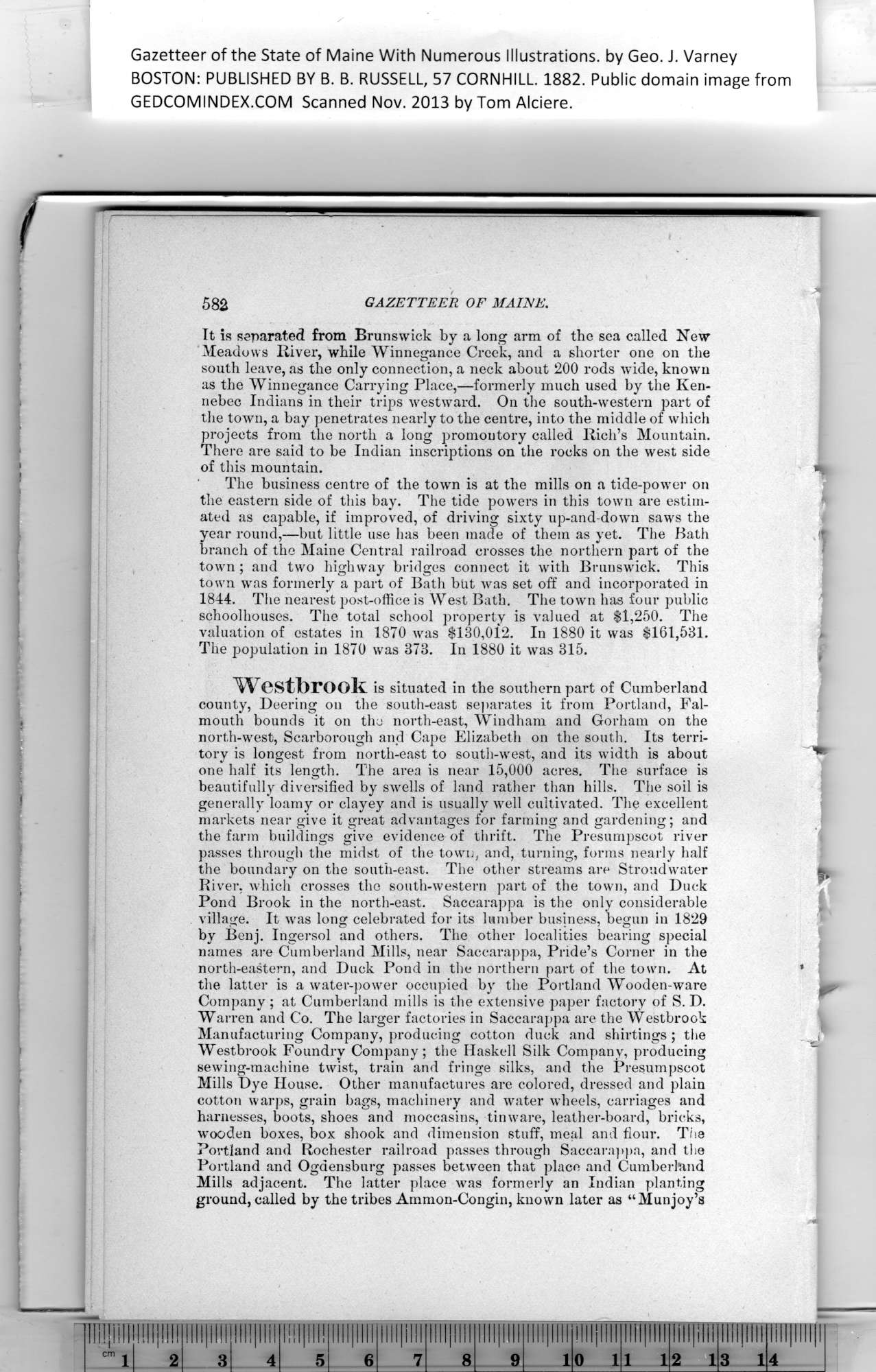|
Gazetteer of the State of Maine With Numerous Illustrations, by Geo. J. Varney
BOSTON: PUBLISHED BY B. B. RUSSELL, 57 CORNHILL. 1882. Public domain image from
582 GAZETTEER OF MAINE.
It is separated from Brunswick by a long arm of the sea called New
Meadows River, while Winnegance Creek, and a shorter one on the
south leave, as the only connection, a neck about 200 rods wide, known
as the Winnegance Carrying Place,—formerly much used by the Ken-
nebec Indians in their trips westward. On the south-western part of
the town, a bay penetrates nearly to the centre, into the middle of which
projects from the north a long promontory called Rich’s Mountain.
There are said to be Indian inscriptions on the rocks on the west side
of this mountain. ^
The business centre of the town is at the mills on a tide-power on
the eastern side of this bay. The tide powers in this town are estim-
ated as capable, if improved, of driving sixty up-and-down saws the
year round,—but little use has been made of them as yet. The Bath 4
branch of the Maine Central railroad crosses the northern part of the
town; and two highway bridges connect it with Brunswick. This
town was formerly a part of Bath but was set off and incorporated in
1844. The nearest post-office is West Bath. The town has four public
schoolhouses. The total school property is valued at $1,250. The
valuation of estates in 1870 was $130,012. In 1880 it was $161,531.
The population in 1870 was 373. In 1880 it was 315.
Westbrook is situated in the southern part of Cumberland
county, Deering on the south-east separates it from Portland, Fal-
mouth bounds it on the north-east, Windham and Gorham on the
north-west, Scarborough and Cape Elizabeth on the south. Its terri- I
tory is longest from north-east to south-west, and its width is about
one half its length. The area is near 15,000 acres. The surface is
beautifully diversified by swells of land rather than hills. The soil is
generally loamy or clayey and is usually well cultivated. The excellent
markets near give it great advantages for farming and gardening; and
the farm buildings give evidence of thrift. The Presumpscot river
passes through the midst of the town, and, turning, forms nearly half
the boundary on the south-east. The other streams are Stroudwater
River, which crosses the south-western part of the town, and Duck
Pond Brook in the north-east. Saccarappa is the only considerable
village. It was long celebrated for its lumber business, begun in 1829
by Benj. Ingersol and others. The other localities bearing special
names are Cumberland Mills, near Saccarappa, Pride’s Corner in the
north-eastern, and Duck Pond in the northern part of the town. At
the latter is a water-power occupied by the Portland Wooden-ware
Company; at Cumberland mills is the extensive paper factory of S. D.
Warren and Co. The larger factories in Saccarappa are the Westbrook
Manufacturing Company, producing cotton duck and shirtings ; the
Westbrook Foundry Company; the Haskell Silk Company, producing
sewing-machine twist, train and fringe silks, and the Presumpscot
Mills Dye House. Other manufactures are colored, dressed and plain
cotton warps, grain bags, machinery and water wheels, carriages and
harnesses, boots, shoes and moccasins, tinware, leather-board, bricks,
wooden boxes, box shook and dimension stuff, meal and flour. The
Portland and Rochester railroad passes through Saccarappa, and the
Portland and Ogaensbnrg passes between that place and Cumberland
Mills adjacent. The latter place was formerly an Indian planting
ground, called by the tribes Ammon-Congin, known later as “Munjoy’s
PREVIOUS PAGE ... NEXT PAGE
This page was written in HTML using a program written in Python 3.2
|
